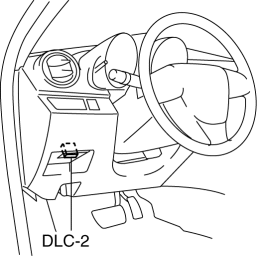Mazda 3 Service Manual: Engine Tune Up [Mzr 2.0, Mzr 2.5]
NOTE:
-
If the accelerator pedal is depressed continuously for a specified time, the engine speed may decrease to the idle speed. This is due to the fuel cut control operation, which prevents overheating, and it does not indicate a malfunction.
Engine Tune-up Preparation
1. Verify the following:
-
MTX: Shift lever is in neutral position.
-
ATX: Selector lever is in P or N position.
2. Warm up the engine to normal operating temperature.
a. Increase the engine speed to 2,5003,000 rpm
until the cooling fan starts running.
b. When the cooling fan starts running, release the accelerator pedal and wait until the cooling fan stops running.
3. Turn off all electrical loads.
4. Connect the M-MDS to the DLC-2.

Idle Speed Inspection
NOTE:
-
Idle speed is not adjustable.
-
Idle speed verification requires M-MDS.
1. Complete the engine tune-up preparation..
2. Verify that the idle speed (M-MDS: RPM) is within the specification..
-
Idle speed (MTX: Neutral position, ATX: P, N position)
-
600700 rpm (MTX), 650750 (ATX)
Ignition Timing Inspection
NOTE:
-
The ignition timing cannot be adjusted.
-
The M-MDS is required to verify the ignition timing.
1. Complete the engine tune-up preparation..
2. Verify the ignition timing (M-MDS: SPARKADV) using the PID/data monitor function of the M-MDS..
-
Ignition timing
-
MZR 2.0: Approx. BTDC 8°
-
MZR 2.5: Approx. BTDC 12°
3. Verify that ignition timing advances when the engine speed increases gradually.
Idle Mixture Inspection
1. Verify that the idle speed and ignition timing are within the specification..
2. Insert an exhaust gas analyzer into the tailpipe.
3. Verify that the CO and HC concentrations are within regulation.
-
CO concentration
-
Within the regulation
-
HC concentration
-
Within the regulation
Idle-up Speed Control Inspection
NOTE:
-
Idle speed is not adjustable.
-
Idle speed verification requires M-MDS.
1. Complete the engine tune-up preparation..
2. Verify that the engine speed (M-MDS: RPM) is within the specification when each load is applied. (The speed decrease just after the load is applied is not considered.).
-
If the engine speed is not within the specification when a specified load is applied, inspect the related input parts, wiring harnesses, and connectors.
-
Idle-up speed (MTX: Neutral position, ATX: P, N position)
-
A/C on: 700800 rpm (MTX), 650770 (ATX)
-
Electrical loads on: 650800 rpm
 Engine SST [Skyactiv G 2.0]
Engine SST [Skyactiv G 2.0]
1: Mazda SST number
2: Global SST number
Example
1:49 UN20 5072
2:205072
Holder
1:
2: 134-01049A
Evaporative emission system teste ...
 Engine Tune Up [Mzr 2.3 Disi Turbo]
Engine Tune Up [Mzr 2.3 Disi Turbo]
NOTE:
If the accelerator pedal is depressed continuously for a specified time,
the engine speed may decrease to the idle speed. This is due to the fuel cut
control operation, which preve ...
Other materials:
Down Switch Inspection [FS5 A EL]
1. Perform the following procedures.
a. Remove the battery cover..
b. Disconnect the negative battery cable.
c. Remove the console..
d. Disconnect the selector lever component connector.
2. Inspect the continuity between the selector lever component terminals C and
H.
If ...
Variable Tumble Shutter Valve Switch Inspection [Mzr 2.0, Mzr 2.5]
Voltage Inspection
NOTE:
The variable tumble shutter valve switch cannot be removed as a single unit.
When replacing the variable tumble shutter valve switch, replace it together
with the intake manifold as a single unit.
1. Connect the M-MDS to the DLC2.
2. Switch the ig ...
Illuminated Entry System
When the illuminated entry system
operates, the overhead light (switch is in
the DOOR position) turn on for:
About 30 seconds after the driver's door
is unlocked and the ignition is switched
off.
About 15 seconds after all doors are
closed and the ignition is switched off.
About 5 se ...
